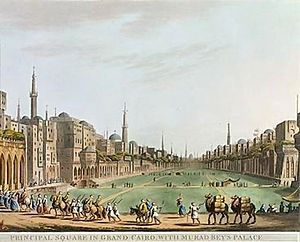Siege of Cairo
| Siege of Cairo | |||||||
|---|---|---|---|---|---|---|---|
| Part of the French Revolutionary Wars | |||||||
 Principle Square In Grand Cairo, With Murad Bey's Palace circa 1801 |
|||||||
|
|||||||
| Belligerents | |||||||
|
|
|
||||||
| Commanders and leaders | |||||||
|
|
|
||||||
| Strength | |||||||
| 14,000 | 20,000 | ||||||
| Casualties and losses | |||||||
| 13,500 captured | Low | ||||||
The Siege of Cairo also known as the Cairo Campaign was a siege that took place during the French Revolutionary Wars, between French and British with Ottoman forces and was the penultimate action of the Egyptian Campaign. British commander John Hely-Hutchinson advanced to Cairo, where he arrived after a few skirmishes in mid June. Joined by a sizeable Ottoman force Hutchinson invested Cairo and on 27 June the surrounded 13,000-strong French garrison under General Augustin Daniel Belliard, out-manned and out-gunned then surrendered. The remaining French troops in Egypt under Jacques-François Menou disheartened by this failure, retired to Alexandria.
With General Ralph Abercromby's death at the Battle of Canope, John Hely-Hutchinson succeeded as commander of the British force in August. On the 26th of April Major General Eyre Coote was left in command of the army before Alexandria while Hutchinson arrived at Rosetta to press home the operations against the French in the interior of the country that lead towards Cairo
The British fifty gun ship HMS Leopard under Commodore John Blankett anchored in the road of Suez on 21 April along with three frigates and sloops and a number of transports. Native troops hired from the East India Company from Bombay amounting to about 6,000 were to support with those disembarked on the shore. On the 22nd at daybreak an officer and a party of the 86th regiment of foot landed from the Leopard and took possession of the town of Suez which the French garrison had previously evacuated. At 8 am the British Union Jack was hoisted on shore and afterwards the transports disembarked their troops. Soon after they consolidated their gains and set up camp while the rest of the force arrived.
...
Wikipedia
